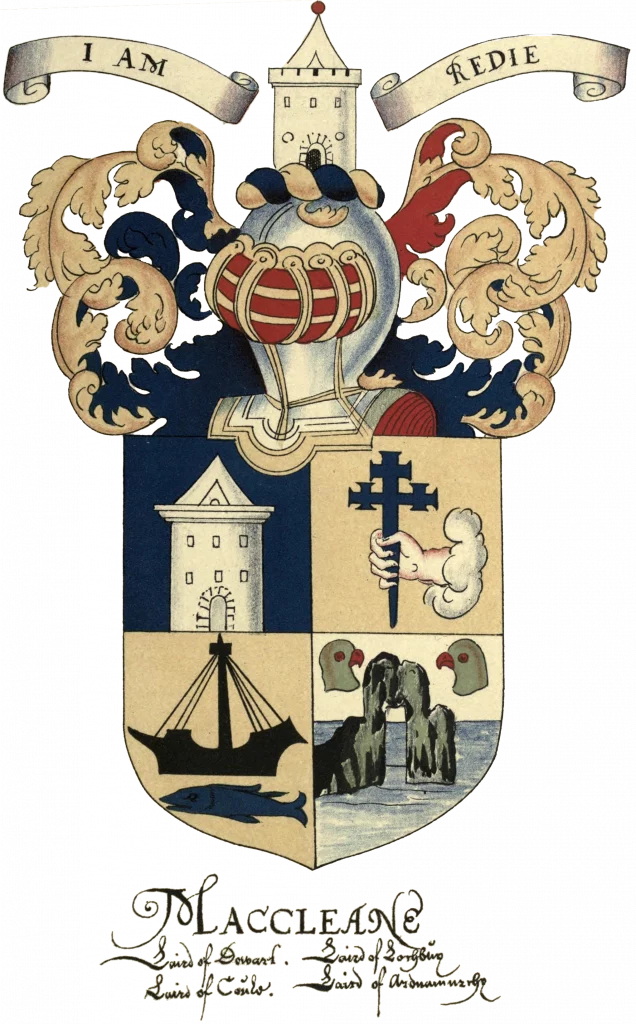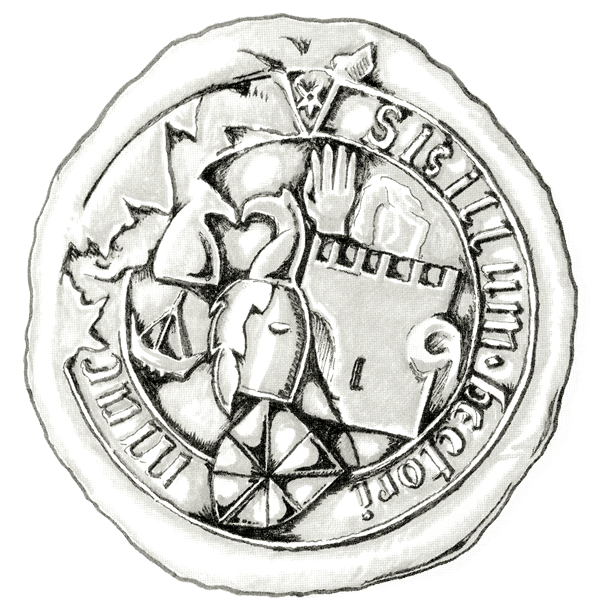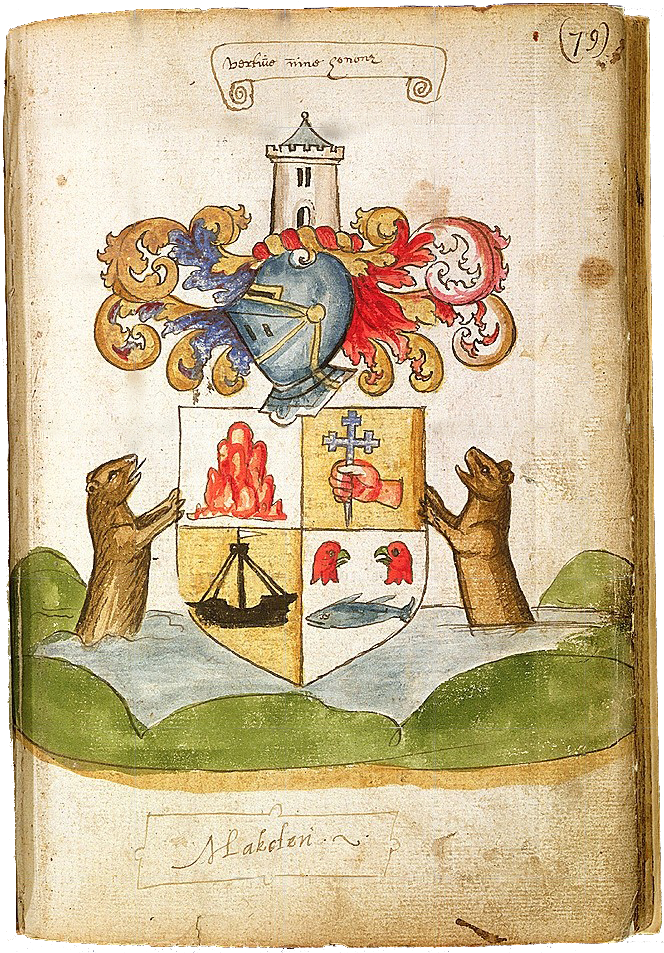The heraldry of the Clan Maclean, its chiefs, and its chieftains shares the characteristics that identify many Scottish clans of the Western Highlands and Isles. Most of the ancient clans of this region were connected to the Lordship of the Isles before the fourteenth century, and their arms reflected it.
The most common element that remains in the arms of the West Highland and Island clans is the lymphad. It alone was the arm of the Lordship, and the vast majority of clans aligned with the Lordship included a lymphad in their chiefs’ arms.1
Per heraldic law and custom an achievement of arms is the property of the individual, or armiger, to whom they have been granted, and were typically inherited undifferenced by the eldest son. In 1936, Catriona Louise MacLean of Ardgour17th successfully challenged the succession of chieftainship in the Lyon Court, and opened the inheritance of titles to women.2
Through the past few centuries the specific characteristics of Maclean achievement of arms have only varied slightly as they were re-matriculated for the Maclean chiefs to reflect changes in status or personal achievements. The primary charges of the escutcheon have remained steadfast—a rock, a red-hand holding a cross, a lymphad, eagle heads, a salmon, and a lion rampant—have been symbols of the Macleans since before they appeared in Hector Mor’s seal in 1546.
The earliest surviving visual record of the Maclean Chief’s arms is found in the Lindsay of the Mount Roll of arms, which was created in 1542 by Sir David Lyndsay of the Mount, Lyon King of Arms.3 While the early matriculation and motto of Hector Mór Maclean of Duart12th differ from the arms we recognize today, all the modern elements are present.
There is little doubt that the tower embattled cold refer to anything other than Duart Castle itself, chartered to Lachlan Lùbanach Maclean of Duart6th in 1390.4
The Maccleane arms in the Lindsay Roll provides the best historical clue for interpreting the origin of the rock which figures into many of the Maclean Chiefs’ arms. Included is an arched rock feature near water, which is most likely a reference to the Carsaig Arches located on the Ross of Mull on the south of the Isle of Mull. In seems likely that in time the reference was lost and the detail of a rock arch gradually became simply a rock, though an altogether different meaning could exist.

The Exchequer Rolls record several occasions when the Maclean Chiefs supplied hawks to the sovereign for personal and military use. The salmon represented wisdom and eternal life to the ancient Gaels as they return to their birthplace to spawn, thus keeping alive the most fundamental tradition; the silver tincture highlights the noble Dálriadic origins of Gilleain na Tuaighe.

The Seal of Hector Mór Maclean affixed to a document dated May 24, 1546 is the earliest surviving seal of a Maclean Chief. The seal endorsed a bond of manrent—a contract of service or vassalage—to Mary of Guise, Dowager Queen of James V in consideration for a tract of her lands he occupied in the isles, presumably Aros and Morvern.11
Hector Mór’s seal contains all the elements of the modern arms of the Macleans. Additionally it is the only seal to include the gyrony of the Campbell arms, probably referencing a 1543 bond of manrent to the Earl of Argyle.11
While it is easy to assume that the red hand holding the blue cross refers to Saint Columba, it most likely refers to Saint Lughaidh, better known as Saint Moluag, who was a contemporary of Saint Columba. Somerled, the Lords of Lorne, and the Lords of the Isles all considered Saint Moluag to be the patron saint of Argyll.5 He was born before 520 in Ulster on Ireland,6 and was one of 6 Irish priests that Saint Patrick rightly prophesied would become bishops.7 When Saint Moluag left Ireland with 12 followers, tradition states that the rock on which he stood broke away from the Irish coast and carried the men to the Isle of Lismore.8 It was on Lismore—a place sacred to the Picts9—that Saint Moluag established a monastery in 562, a hundred would follow before his death in 592.10 An ancestor of Gilleain na Tuaighe was the Abbot of the Lismore monastery. The red hand is a well known ancient reference to Ulster, and the cross crossed fitchée references evangelism. When used together in the West Highlands, probably recognizes Saint Moluag, the Christian evangelist from Ulster as he is more specific to the area.
In 1591 what we recognize today as the undifferenced arms of the Maclean Chief appear in the Seton Armorial. The Chief represented in the Seton Armorial was Lachlan Mór Maclean of Duart14th under the spelling ‘Makelen.’12
Only half a century after the Lindsay of the Mount Roll was established, the arch no longer appears in the rock nor does the water it was near. The imagery and tinctures use the elements of the West Highlands and Isles, and continue to reference the Lordship of the Isles though it had been annexed to Scotland a century earlier.
The changes to the supporters, compartment, and adornments remained the same until the late 19th century matriculations reflected personal achievements. However the escutcheon has remained fixed for nearly five centuries.

Under heraldic law, the Chief’s arms are his personal property. To demonstrate membership and allegiance with the chief members of the Clan Maclean used a heraldic device known as a badge devised by encircling the Chief’s crest in a strap and buckle. All members, allies, and supporters of the clan are encouraged to wear, use, and display the Clan Maclean badge.
The Celtic clans Scotland began using tartan as early as the 8th century BCE; over time these pattern trends could be used to identity specific clans just as particular weaving designs can be used to identify Native American tribes. However it wasn’t until the early 19th century that the “tradition” of clan-specific tartans was invented for the 1822 visit of King George IV to Scotland. A Maclean hunting tartan is the oldest recorded tartan in Scotland. It is described in a land charter for Nerrabolsadh on Islay in 1587.
Today wearing tartan is a very common form of every-day heraldry. The Macleans has four primary tartans— the regular or dress tartan which is red and a hunting (or casual) tartan which is green or blue.
